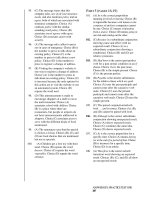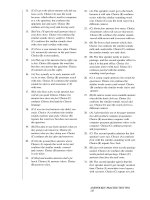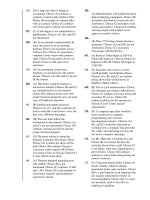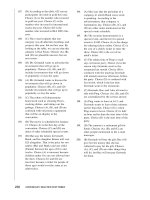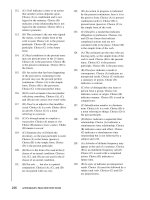Longman Preparation Series For The TOEIC Test- Introductory Course
Bạn đang xem bản rút gọn của tài liệu. Xem và tải ngay bản đầy đủ của tài liệu tại đây (43.03 MB, 391 trang )
CONTENTS
INTRODUCTION
Vll
To the Student viii
To the Teacher IX
About the new TOEIC@Test xii
Tips for taking the new TOEIC test xii
New TOEIC Test Directions xiii
New TOEIC Test Answer Sheets xiv
LISTENING COMPREHENSION 1
PARTI PHOTOS 2
Photos of people 3
Photos of things 16
Strategy Review 29
Stra tegy Practice 32
PART 2 QUESTION-RESPONSE 37
Identifying time 38
Identifying people 39
Identifying an opinion 41
Identifying a choice 42
Identifying a suggestion 44
Identifying a reason 45
Identifying a location 47
Stra tegy Review 49
Strategy Practice 50
PART 3 CONVERSATIONS
51
Identifying time 52
Identifying people 55
Identifying intent 58
Identifying the topic 61
Identifying a reason 63
Identifying a location 66
Identifying an opinion 68
Identifying stress and tone 71
Stra tegy Review 74
Strategy Practice 75
CONTENTS
iii
PART 4-TALKS
Identifying the sequence
Identifying the audience
Identifying a situation
Identifying the topic
Identifying a request
Strategy Review
Stra tegy Practice
LISTENING COMPREHENSION REVIEW
READING
PART 5-INCOMPLETE SENTENCES
Word families
Similar words
Preposi tions
Conjunctions
Adverbs of frequency
Causative verbs
Conditional sentences
Verb tense
Two-word verbs
Strategy Review
Strategy Practice
PART 6-TEXT COMPLETION
Words in context
Pronouns
Subject-verb agreement
Modal auxiliaries
Adjective comparisons
Gerunds or infinitives
Strategy Review
Strategy Practice
PART 7-READING COMPREHENSION
Reading Strategies
Practice: Reading Comprehension
Ad vertisemen ts
Business correspondence
Forms, charts, and graphs
Articles and reports
Announcements and paragraphs
iv
CONTENTS
78
78
81
83
85
87
90
91
94
107
108
109
111
113
115
117
119
121
123
124
126
127
129
130
132
135
138
141
143
146
147
150
151
153
153
156
159
162
165
168
Strategy Review
Strategy Practice
169
READING REVIEW
180
PRACTICE TESTS
209
Practice Test One
209
Practice Test Two
249
ANSWER SHEETS
290
Listening Comprehension Review
291
Reading Review
291
Practice Test One
293
Practice Test Two
295
AUDIO SCRIPTS
297
Listening Comprehension
298
Listening Comprehension Review
317
Practice Test One
323
Practice Test Two
329
ANSWER KEYS
335
Listening Comprehension
337
Listening Comprehension Review
342
Reading
349
Reading Review
351
Practice Test One
358
Practice Test Two
370
CONTENTS
v
PHOTO CREDITS
CORBIS/Royalty-Free
page 98 (top); page 99 (bottom); page 212 (bottom); page 214 (bottom); page 252
(bottom); page 253 (top); page 254 (bottom)
Educational Testing Service
pages 2; 94; 210; 250
Instructional Design International, Inc.; Washington, D.C.
page 4; page 10; page 13; page 17; page 20; page 26; page 30; page 31; page 33 (both);
page 34 (both); page 35 (both); page 36 (both); page 95 (both); page 96 (both); page 97
(top); page 98 (bottom); page 99 (top); page 211 (both); page 212 (top); page 213
(both); page 214 (top); page 215 (both); page 247 (both); page 251 (both); page 252
(top); page 254 (top); page 255 (both)
O'Toole, Steve
page 7; page 23; page 32 (both); page 97 (bottom); page 253 (bottom)
vi
PHOTO CREDITS
INTRODUCTION
INTRODUCTION
TO THE STUDENT
The new TOEIC@(Test of English for International Communication) test measures your
ability to understand English. It also measures your ability to take a standardized,
multiple-choice test. In order to score well on the new TOEIC test, you must have two
goals: improve your proficiency in English and improve your test-taking skills. The
Longman Preparation Series for the new TOEIC Test will help you do both.
Goal 1:
Improving your proficiency in English
The
Longman Preparation Series for the New TOEIC@ Test
will help you build your
vocabulary. It will introduce you to words that are often used on the new TOEIC test.
These are words that are used frequently in general English and also in business
English contexts. You will learn words used by businesspeople involved in making
contracts, marketing, planning conferences, using computers, writing letters, and
hiring personnel. You will learn the words to use when shopping, ordering supplies,
examining financial statements, and making investments. You will also learn general
English terms often found in business contexts. This includes words used for travel
and entertainment and for eating out and taking care of one's health.
The
Longman Preparation Series for the New TOEIC@ Test
will help you review English
grammar. The grammar items commonly tested on the new TOEIC test are reviewed
here. You will learn grammar structures in TOEIC contexts.
Goal 2: Improving your test-taking skills
The
Longman Preparation Series for the New TOEIC@ Test
will teach you to take the new
TOEIC test efficiently. It will help you understand what a question asks. It will help
you analyze the test items so you will know what tricks and traps are hidden in the
answer choices. It will familiarize you with the format of the test so you will feel
comfortable when taking the test. You will know what to expect. You will know what
to do. You will do well on the new TOEIe.
viii
INTRODUCTION
TO THE TEACHER
As a teacher, you want your students to become proficient in English, but you know
your student's first goal is to score well on the new TOEIC@test. Fortunately, with the
Longman Preparation Series for the New TOEIC@ Test,
both your goals and the students'
goals can be met. All activities in the Longman Preparation Series match those on the
actual new TOEIC test. Every practice exercise a student does prepares him or her for a
similar question on the test. You do not, however, have to limit yourself to this
structure. You can take the context of an item and adapt it to your own needs. I call this
teaching technique "UPP service": Look at; Identify; Paraphrase; Personalize. UPP
service makes the students repeat the target words and ideas in a variety of ways.
Repetition helps students learn English. Variety keeps them awake. Here are some
examples on how UPP service can "serve" you in your classroom for each of the seven
parts of the new TOEIC test.
Part 1: Photos
L Have the students look at the photo.
I Have the students identify all the words in the photo. Have them determine who is
in the photo, what they are doing, and where they are standing. If there are no
people, have them determine what is in the photo and describe it.
P Have the students paraphrase the sentences they used when identifying the people
or objects in the photo. This can be very simple, but it teaches the versatility and
adaptability of language. For example, the students identify in the picture a man
getting on the bus. Paraphrase:
A passenger is boarding the bus.
The students can also
enrich the sentence by adding modifiers:
A young man is about to get on the city bus.
P Have the students personalize their statements. Start with simple sentences such as
I am getting on the bus
and expand to short stories:
Every morning, I wait for the bus
on the corner. The bus stop is between Fifth and Sixth Street on the west side of the street.
There are often many people waiting for the bus, so we form a line.
Part 2: Question-Response
L Have the students listen to the question and three responses.
I Have the students identify all the words in the question and three responses. They
can take dictation from the audio program or from you.
P Have the students paraphrase the question or statement they hear.
You're coming,
aren't you?
can be paraphrased as
I hope you plan to come.
Options such as,
Yes, of
course.
can be paraphrased as
Sure.
INTRODUCTION
ix
P Have the students personalize their statements. The students can work in pairs and
develop small dialogues:
You're coming to my house tonight, aren't you? No, I'm sorry.
I have to study.
Part 3: Conversations
L Have the students listen to the conversations and look at the three questions and
answer options in the book.
I Have the students identify all the words in the short conversations, the three
written questions, and possible answers.
P Have the students paraphrase th~ sentences. The method is the same as for Parts 1
and 2. The students will demonstrate their understanding of the individual
sentences by providing a paraphrase.
P Have the students personalize their statements. If the conversation is about dining
out, the students can make up their own short conversation about a dining
experience that they had. They should work in pairs or small groups for this
exercise.
Part 4: Talks
L Have the students listen to the talks and look at the question(s) and answer options
in the book.
I Have the students identify all the words in the talks, the written question(s), and
possible answers.
P Have the students paraphrase the sentences.
P Have the students personalize their statements. Have them work in pairs or groups
to create a similar talk. Have different individuals from the same group stand and
give the talk. It will be interesting to see which vocabulary and grammar patterns
they choose to share.
Part 5: Incomplete Sentences
L Have the students look at the statement and four responses.
I Have the students identify all the words in the statement and four responses.
P Have the students paraphrase the statement. They can also create sentences with
the answer options that did not complete the blank in the original statement.
x
INTRODUCTION
P Have the students personalize their statements. The students may find it difficult
to find something in common with the whole statement, but they might be able to
isolate one word and create some personal attachment. For example, in
QUI'
clients
are satisfied with their cOlI/puter systell/,
your students may not have clients, but they
will probably have a computer:
I
all/ satisfied with my persona! computer.
Part 6: Text Completion
1. Have the students read the statement with the blank.
2. Have the students read the answer options.
3. Ask the students if they can complete the blank by just reading the statement with
the blank.
4. If not, the students will have to look for references in the passage. Have them try to
find synonyms or paraphrases to the answer options in the passage.
5. Have them make up a sentence with each answer option.
Part 7: Reading Comprehension
L Have the students look at the passage.
I Have the students identify all the words in the passage.
P Have the students paraphrase the passage. If the passage is an advertisement,
have them create a new advertisement for the same product. If the passage is a
timetable, put the timetable in a different format.
P Have the students personalize the passage. Advertisements can be turned into a
student's personal classified ad. A diary can be turned into a student's own
schedule. A report can be turned into a student's essay on the same subject. With a
little imagination, you can find a way to personalize almost any reading passage.
INTRODUCTION
xi
ABOUT THE NEW TOEIC@ TEST
The new Test of English for International Communication (TOEIC) is a multiple-choice
test of English for adult, nonnative speakers of the language. The test uses the language
of international business. It has two sections: Listening Comprehension and Reading.
Listening
Comprehension
Part 1 Photos
Part 2 Question-Response
Part 3 Conversations
Part 4 Talks
10
30
30
30
TOTAL 100
45 minutes
Reading
Part 5 Incomplete Sentences 40
Part 6 Text Completion 12
Part 7 Reading Comprehension
• Single Passages 28
• Double Passages 20
TOTAL 100
75 minutes
The TOEIC test is scored on a scale of 10 to 990. Only correct responses count toward
your score. These correct responses are added and converted to a TOBIC score.
Tips for Taking the New TOEle Test
Be familiar with the directions before you take the exam.
The directions are the same on every exam. If you study the directions in this book,
which are identical to those on the actual new TOBIC, you don't need to read them
on the day of the exam. Instead you can study the photos, read the answer options,
and take more time to answer the questions themselves.
Work rapidly, but carefully.
Train yourself to work quickly. Train yourself to be thorough.
Guess.
If you do not know the answer, guess. You are not penalized for wrong answers,
and you may get it right.
Mark only one answer per question.
Any question with more than one answer blackened will be counted as wrong.
Use the strategies and tips that you learned in this book.
This book was written so you can score higher on the new TOBIC test. Use these
strategies and tips for success.
xii
INTRODUCTION
NEW TOEIC@ TEST DIRECTIONS
General Directions
These directions are provided by the Educational Testing Service (ETS) and are
reprinted here with their permission. Read them and make sure you understand them.
These directions are the same on every test.
@>.
TOE/C.
Test of English for International Communication
General Directions
This test is designed to measure your English language ability. The test is divided into two
sections: Listening and Reading.
You must mark all of your answers on the separate answer sheet. For each question, you
should select the best answer from the answer choices given. Then, on your answer sheet,
you should find the number of the question and fill in the space that corresponds to the
letter of the answer that you have selected. If you decide to change an answer, completely
erase your old answer and then mark your new answer.
Specific Directions
Each part of the new TOEIC test begins with specific directions for that part. In this
book, you will find these directions at the beginning of each study section and in the
Practice Tests. Read them and be sure you understand them.
INTRODUCTION
xiii
NEW TOEIC@ TEST ANSWER SHEETS
The Answer Sheets used in this book are similar to those used in the new TOEIC test.
The precise format of the Answer Sheets varies from test site to test site.
To record a response to a test question, examinees should find the number on the
answer sheet that corresponds to the test question and make a solid mark with a
pencil, filling in the space that corresponds to the letter of the answer they have
chosen.
xiv
INTRODUCTION
__ c.= _ •
LISTENING
COMPREHEN
N
In the first section of the new TOEIC@test, you will be tested on how
well you understand spoken English. There are four parts to this section
with special directions for each part:
Part 1
Part 2
Part 3
Part 4
Photos
Question- Response
Conversations
Talks
Each part contains activities to help you practice these strategies. Each
part ends with a Strategy Review consisting of questions similar to
those on the new TOEIC test. In this part of the Introductory Course for
the new TOEIC Test, you will learn strategies to help you on the
Listening Comprehension section.
PART I-PHOTOS
These are the directions for Part 1 of the new TOEIC@test. Study them now. If you
understand these directions now, you will not have to read them during the test.
LISTENING TEST
In the Listening test, you will be asked to demonstrate how well you understand spoken English.The
entire Listening test will last approximately 45 minutes.There are four parts, and directions are given for
each part.You must mark your answers on the separate answer sheet. Do not write your answers in the
test book.
PART 1
Directions: For each question in this part, you will hear four statements about a picture in your test book.
When you hear the statements, you must select the one statement that best describes what you see in the
picture. Then find the number of the question on your answer sheet and mark your answer. The statements
will not be printed in your test book and will be spoken only one time.
Example
Sample Answer
00.@
Statement (C), "They're standing near the table," is the best description of the picture, so you
should select answer (C) and mark it on your answer sheet.
2
LISTENING COMPREHENSION
In
this part you will learn how to look at photographs. These are the types of
photographs you will see:
photos of people
photos of things
PHO,TOS OF PEOPLE
You will see photos of people in Part 1. You will hear statements about the people that
may give information about:
Who are they?
Where are they?
Wha t are they doing?
What do they look like?
PHOTOS 3
PHOTO 1
A.
WHO ARE THE PEOPLE?
Look at the photo above. Make assumptions about the
occupation or relationship of the people in the photo.
Write Y (Yes), N (No), or
?
(Unsure) beside the following relationships or
occupations.
1.
brother and sister
2.
father and son
3.
boss and worker
4.
employees
5.
colleagues
6.
workers
7.
clerks
8.
repair personnel
9.
landlords
10.
shipping agents
11.
dentists
12.
mechanic and customer
4
LISTENING COMPREHENSION
B. WHERE ARE THE PEOPLE? Try to determine the setting. Pay attention to the
prepositions such as
next to,
ill
front of,
and
at.
Write Y (Yes), N (No), or ? (Unsure) beside the following locations.
1.
in an office
2.
on the job
3.
at home
4.
next to a school
5.
on the bus
6.
at work
7.
in the street
8.
in a hallway
9.
behind a desk
10.
by a work station
11.
in front of a window
12.
in a conference room
C. WHAT ARE THE PEOPLE DOING? Identify the appropriate action.
Use these words to complete the sentences:
facing
giving sitting taking
touching
1.
The man on the righ t is
a box from the man on the left.
2.
The man on the left is
a box to the man on the right.
3.
Both men are
one another.
4.
Neither man is
down.
5.
Both men are
the box.
PHOTOS 5
D.
WHAT DO THE PEOPLELOOK LIKE?
How would you describe these people?
Write Y(Yes)if the description is true. If it is not, rewrite the sentence to make
it true.
1.
2.
3.
4.
5.
6.
7.
8.
Both men are wearing jackets.
The man on the right is wearing a tie.
Both men are wearing glasses.
One man has a watch on his right hand.
There are a lot of people in the office.
Both men are wearing dark shirts.
The box is big and heavy.
The man on the left is wearing a vest.
6 LISTENING COMPREHENSION
PHOTO 2
A.
WHO ARE THE PEOPLE?
Look at the photo above. Make assumptions about the
occupation or relationship of the people in the photo.
Write Y (Yes), N (No), or
?
(Unsure) beside the following relationships or
occupations.
1.
father and son
2.
brothers
3.
colleagues
4.
speaker and panelist
5.
master of ceremonies and speaker
6.
employer and employee
7.
political opponents
8.
construction managers
9.
architects
10.
service technicians
11.
teacher and administrator
12.
teacher and student
PHOTOS 7
B.
WHERE ARE THE PEOPLE?
Try to determine the setting. Pay attention to the
prepositions such as
next to, infront of,
and
at.
Write Y (Yes), N (No), or
?
(Unsure) beside the following locations.
1.
under the painting
2.
on the desk
3.
behind the podium
4.
between the two tables
5.
at the table
6.
next to one another
7.
across the street
8.
at the podium
9.
in front of the podium
10.
between the paintings
11.
behind the microphones
12.
o
above the water pitchers
C.
WHAT ARE THE PEOPLE DOING?
Identify the appropriate action.
Use these words to complete the sentences:
addressing
expressing
listening
sitting
standing
1. The man at the podium is an audience.
2. The man to the speaker has his elbow on the table.
3. The speaker is at the podium.
4. The honoree is his thanks.
5. The next speaker is at the table beside the podium.
8 LISTENING COMPREHENSION
D.
WHAT DO THE PEOPLELOOK LIKE?
How would you describe these people?
Write Y (Yes)if the description is true. If it is not, rewrite the sentence to make
it true.
1.
2.
3.
4.
5.
6.
7.
8.
Both men are wearing suits.
Only one man is wearing a tie.
Only one man is wearing glasses.
One man is dressed casually.
The man behind the podi urn is wearing a ha t.
One man is wearing a dark suit.
Both men have a lot of hair.
The man sitting down has a handkerchief in his suit pocket.
PHOTOS 9
PHOTO 3
A.
WHO ARE THE PEOPLE?
Look at the photo above. Make assumptions about the
occupation or relationship of the people in the photo.
Write Y (Yes), N (No), or
?
(Unsure) beside the following relationships or
occupations.
1.
husband and wife
2.
brothers
3.
construction workers
4.
file clerks
5.
lawyer and client
6.
metal workers
7.
computer technicians
8.
doctor and patient
9.
building inspectors
10.
assembly line workers
11.
circus performers
12.
dock hands
10
LISTENING COMPREHENSION
B.
WHERE ARE THE PEOPLE?
Try to determine the setting. Pay attention to the
prepositions such as
next to, in front of,
and
at.
Write Y (Yes),N (No), or? (Unsure) beside the following locations.
1.
at a construction site
2.
in a basement
3.
on the roof
4.
on a girder
5.
at the drug store
6.
at the payroll office
7.
on a support beam
8.
in a clinic
9.
by a telephone pole
10.
near a bridge
11.
on a trolley
12.
around back
C.
WHAT ARE THE PEOPLE DOING?
Identify the appropriate action.
Use these words to complete the sentences:
constructing
following
holding
walking watching
1. The construction workers are where they are going.
2. They are a new building.
4. One man is the other.
5. The workers are across the support beam.
PHOTOS
11
D.
WHAT DO THE PEOPLE LOOK LIKE?
How would you describe these people?
Write Y (Yes)if the description is true. If it is not, rewrite the sentence to make
it true.
1.
2.
3.
4.
5.
6.
7.
8.
Both men are wearing hard hats.
Both men are wearing similar construction uniforms.
One man is not wearing shoes.
One man is wearing gloves.
The man in front is wearing a sport coat.
The man behind is wearing light colored pants.
Both men have dark hard hats.
Both men are wearing shorts.
12
LISTENING COMPREHENSION
PHOTO 4
A.
WHO ARE THE PEOPLE?
Look at the photo above. Make assumptions about the
occupation or relationship of the people in the photo.
Write Y (Yes),N (No), or
?
(Unsure) beside the following relationships or
occupations.
1. aunt and niece
2. mother and daughter
3. customer and salesperson
4. pharmacist and client
5. doctor and patient
6. TV technician and actress
7. student and teacher
8. security guard and electrician
9. insurance salesperson and health care provider
10. hairstylist and client
11. strangers
12. carpenter and homeowner
PHOTOS
13



